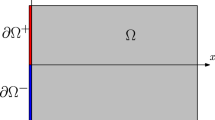Abstract
The restoration of boundary conditions in one-dimensional transient inverse heat-conduction problems (IHCP) is described. In the formulation, the boundary conditions are represented by linear relations between the temperature and the heat flux, together with an initial condition as a function of space. The temperature inside the solution domain, together with the space or time-dependent ambient temperature of the environment surrounding the heat conductor, are found from additional boundary-temperature or average boundary-temperature measurements. Numerical results obtained using the boundary-element method are presented and discussed.
Similar content being viewed by others
References
Beck JV, Blackwell B and St. Clair CR, ( 1985). Inverse heat conduction: Ill-posed problems. John Wiley, New York
Beck JV and Murio DA (1986). Combined function-specification regularization procedure for solution of inverse heat conduction problem. AIAA J 24: 180–185
Lesnic D, Elliott L and Ingham DB (1996). Application of the boundary element method to inverse heat conduction problems. Int J Heat Mass Transfer 39: 1503–1517
Lesnic D, Elliott L and Ingham DB (1998). An alternating algorithm for solving the backward heat conduction problem using an elliptic approximation. Inverse Probl Eng 6: 255–279
Mera NS, Elliott L, Ingham DB and Lesnic D (2001). An iterative boundary element method for solving the one dimensional backward heat conduction problem. Int J Heat Mass Transfer 44: 1937–1946
Lesnic D, Elliott L and Ingham DB (1996). Identification of the thermal conductivity and heat capacity in unsteady nonlinear heat conduction problems using the boundary element method. J Comput Phys 126: 410–420
Lesnic D, Elliott L, Ingham DB, Clennell B and Knipe RJ (1997). A mathematical model and numerical investigation for determining the hydraulic conductivity of rocks. Int J Rock Mech Minning Sci 34: 741–759
Lesnic D, Elliott L, Ingham DB, Clennell B and Knipe RJ (1999). The identification of piecewise homogeneous thermal conductivity of conductors subjected to a heat flow test. Int J Heat Mass Transfer 42: 143–152
Mera NS, Elliott L, Ingham DB and Lesnic D (2001). Use of the boundary element method to determine the thermal conductivity tensor of an anisotropic medium. Int J Heat Mass Transfer 44: 4157–4167
Farcas A, Elliott L, Ingham DB, Lesnic D and Mera NS (2003). A dual reciprocity boundary element method for the regularised numerical solution of the inverse source problem associated to the Poisson equation. Inverse Prob Eng 11: 123–139
Farcas A and Lesnic D (2006). The boundary element method for the determination of a heat source dependent on one variable. J Eng Math 54: 375–388
Rap A, Elliott L, Ingham DB, Lesnic D and Wen X (2006). An inverse source problem for the convection-diffusion equation. Int J Numer Meth Heat & Fluid Flow 16: 125–150
Chantasiriwan S (1999). Inverse heat conduction problem of determining time-dependent heat transfer coefficients. Int J Heat Mass Transfer 42: 4275–4285
Divo E, Kassab AJ, Kapat JS and Chyu MK (2005). Retrival of multidimensional heat transfer coefficient distributions using an inverse BEM-based regularised algorithm: numerical and experimental results. Eng Anal Boundary Element 29: 150–160
Maillet D, Degiovanni A and Pasquetti R (1991). Inverse heat conduction applied to the measurements of heat transfer coefficient on a cylinder: Comparison between an analytical and a boundary element technique. J Heat Transfer 113: 549–557
Kostin AB and Prilepko AI (1996). On some problems of restoration of a boundary condition for a parabolic equation I. Diff Eqs 32(1): 113–122
Kostin AB and Prilepko AI (1996). Some problems of restoring the boundary condition for a parabolic equation. II. Diff Eqs 32(11): 1515–1525
Ingham DB, Yuan Y (1994) Boundary element method for improperly posed problems. Comput. Mech. Publ., Southampton
Kurpisz K, Nowak AJ (1995) Inverse thermal problems. Comput. Mech. Publ., Southampton
Ingham DB, Wrobel LC (eds) (1997) Boundary integral formulations for inverse analysis. Comput. Mech. Publ., Southampton
Trombe A, Suliman A and Le Maoult (2003). Use of an inverse method to determine natural convection heat transfer coefficients in unsteady state. J Heat Transfer 125: 1017–1026
Tikhonov AN and Arsenin VY (1977). Solution of ill-posed problems. Winston-Wiley, Washington, DC
Özisik MN (1989). Boundary value problems of heat conduction. Dover Publications, New York
Brebbia CA, Telles JCF and Wrobel LC (1984). Boundary element techniques. Springer-Verlag, Berlin
Hansen PC (1992). Analysis of discrete ill-posed problems by means of the L-Curve. SIAM Rev 34: 561–580
Carslaw HS and Jaeger JC (1959). Conduction of heat in solids, 2nd edn. Clarendon Press, Oxford
Lesnic D, Elliott L and Ingham DB (1998). The boundary element solution of the Laplace and biharmonic equations subjected to noisy boundary data. Int J Numer Meth Eng 47: 479–492
Author information
Authors and Affiliations
Corresponding author
Rights and permissions
About this article
Cite this article
Onyango, T.T.M., Ingham, D.B. & Lesnic, D. Restoring boundary conditions in heat conduction. J Eng Math 62, 85–101 (2008). https://doi.org/10.1007/s10665-007-9192-0
Received:
Accepted:
Published:
Issue Date:
DOI: https://doi.org/10.1007/s10665-007-9192-0




